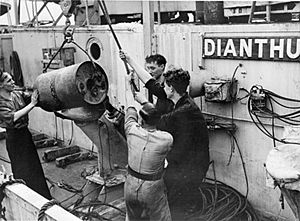Convoy ON 166 facts for kids
Quick facts for kids Convoy ON 166 |
|||||||
|---|---|---|---|---|---|---|---|
| Part of Battle of the Atlantic | |||||||
 A depth charge being loaded onto a depth-charge thrower aboard the corvette HMS Dianthus |
|||||||
|
|||||||
| Belligerents | |||||||
| Commanders and leaders | |||||||
| CAPT W E B Magee RN CAPT P.R. Heineman USN |
Admiral Karl Dönitz | ||||||
| Strength | |||||||
| 63 freighters 1 destroyer 2 cutters 5 corvettes |
18 submarines | ||||||
| Casualties and losses | |||||||
| 14 freighters sunk (87,994 GRT) 262 killed/drowned |
3 submarines sunk 128 killed/drowned 11 captured |
||||||
Convoy ON 166 was a group of merchant ships traveling together for safety during World War II. This convoy was the 166th in a series of convoys that sailed from the British Isles to North America. It included 63 cargo ships, also called freighters. They left Liverpool, England, on February 11, 1943. The next day, they met their protectors, a group of escort ships. These escorts included two cutter ships, the Campbell and Spencer, and five corvette ships: Dianthus, Chilliwack, Rosthern, Trillium, and Dauphin.
Contents
Why Convoys Were Needed
During World War II, German submarines, called U-boats, tried to sink merchant ships carrying supplies across the Atlantic Ocean. This was part of the Battle of the Atlantic. At first, U-boats had a lot of success near the American coast. This period was sometimes called the "second happy time" for the U-boats.
However, as coastal convoys became better protected, the German U-boat commander, Admiral Karl Dönitz, moved his U-boats to the middle of the Atlantic. He hoped to find convoys there, away from air patrols. The Germans also tried to use secret code-breaking to find out where the convoys were going. Even with these efforts, only about 20% of the convoys sailing between July 1942 and April 1943 lost ships to U-boat attacks.
The Battle Begins: February 21
On February 20, 1943, a German U-boat, U-604, spotted Convoy ON 166. The convoy ships were spread out because they had been sailing through a strong storm for eight days.
Early on February 21, another U-boat, U-332, hit a Norwegian ship named Stigstad with a torpedo. This ship had fallen behind the main convoy. Later that afternoon, a British B-24 Liberator aircraft sank the U-boat U-623. That evening, the escort ship Campbell attacked a U-boat. After the war, it was thought that Campbell sank U-225. However, newer information suggests it might have been U-529.
Later that night, a U-boat named U-92 hit two more ships with torpedoes. These were the British Empire Trader and the Norwegian NT Nielsen Alonso. Both ships were badly damaged. Another Polish warship, ORP Burza, from a nearby convoy, was sent to help protect Convoy ON 166.
More Attacks: February 22
After sunset on February 22, the U-boat U-606 hit three more ships: the British Empire Redshank and the American Chattanooga City and Expositor. But then, the Burza attacked U-606 with depth charges, damaging the U-boat.
During this fight, the escort ship Campbell accidentally crashed into the damaged U-606. Both ships were badly hurt. Twelve German sailors were rescued from the sinking U-boat. The Burza then had to leave the convoy to tow the damaged Campbell back to port.
Meanwhile, a special rescue ship called Stockport was returning to the convoy after saving sailors from the three ships sunk by U-606. But then, U-604 attacked and sank the Stockport as well.
The Fight Continues: February 23
The U-boats kept attacking. Early on February 23, U-628 hit the Panamanian ship Winkler and the Norwegian ship Glittre. Around the same time, U-186 torpedoed the American ship Hastings and the British ship Eulima.
The escort ships Spencer, Rosthern, and Chilliwack stayed with the convoy to protect the remaining ships. The Dianthus had to leave to get more fuel.
Final Days of Attack: February 24-25
Before dawn on February 24, U-600 hit the Norwegian ship Ingria. Later, U-653 torpedoed the American Liberty ship Jonathan Sturges, which had fallen behind the convoy.
The attacks continued into the next day. Before dawn on February 25, U-628 hit the British ship Manchester Merchant with two torpedoes.
Aftermath of the Battle
The U-boats finally stopped their attacks on February 26. The ships that survived the battle continued their journey. On February 28, they were joined by another ship, the Empire Cavalier, and more escorts from Halifax, Nova Scotia. These escorts were New Westminster, Blairmore, and Rimouski. The convoy finally reached New York City on March 3, 1943.
In total, 14 merchant ships were sunk during Convoy ON 166, and 262 sailors lost their lives. The German U-boats lost 3 submarines, and 128 of their crew members were killed. 11 German sailors were captured.
Images for kids
See also
- Convoy Battles of World War II


